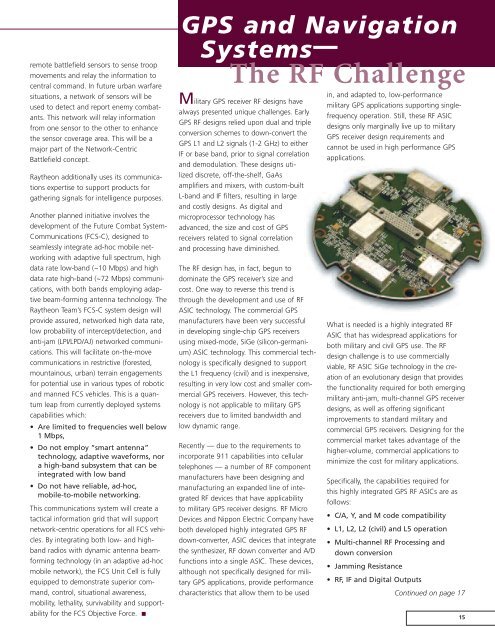Technology Today Volumn 3 Issue 1 - Raytheon
Technology Today Volumn 3 Issue 1 - Raytheon
Technology Today Volumn 3 Issue 1 - Raytheon
Create successful ePaper yourself
Turn your PDF publications into a flip-book with our unique Google optimized e-Paper software.
emote battlefield sensors to sense troop<br />
movements and relay the information to<br />
central command. In future urban warfare<br />
situations, a network of sensors will be<br />
used to detect and report enemy combatants.<br />
This network will relay information<br />
from one sensor to the other to enhance<br />
the sensor coverage area. This will be a<br />
major part of the Network-Centric<br />
Battlefield concept.<br />
<strong>Raytheon</strong> additionally uses its communications<br />
expertise to support products for<br />
gathering signals for intelligence purposes.<br />
Another planned initiative involves the<br />
development of the Future Combat System-<br />
Communications (FCS-C), designed to<br />
seamlessly integrate ad-hoc mobile networking<br />
with adaptive full spectrum, high<br />
data rate low-band (~10 Mbps) and high<br />
data rate high-band (~72 Mbps) communications,<br />
with both bands employing adaptive<br />
beam-forming antenna technology. The<br />
<strong>Raytheon</strong> Team’s FCS-C system design will<br />
provide assured, networked high data rate,<br />
low probability of intercept/detection, and<br />
anti-jam (LPI/LPD/AJ) networked communications.<br />
This will facilitate on-the-move<br />
communications in restrictive (forested,<br />
mountainous, urban) terrain engagements<br />
for potential use in various types of robotic<br />
and manned FCS vehicles. This is a quantum<br />
leap from currently deployed systems<br />
capabilities which:<br />
• Are limited to frequencies well below<br />
1 Mbps,<br />
• Do not employ “smart antenna”<br />
technology, adaptive waveforms, nor<br />
a high-band subsystem that can be<br />
integrated with low band<br />
• Do not have reliable, ad-hoc,<br />
mobile-to-mobile networking.<br />
This communications system will create a<br />
tactical information grid that will support<br />
network-centric operations for all FCS vehicles.<br />
By integrating both low- and highband<br />
radios with dynamic antenna beamforming<br />
technology (in an adaptive ad-hoc<br />
mobile network), the FCS Unit Cell is fully<br />
equipped to demonstrate superior command,<br />
control, situational awareness,<br />
mobility, lethality, survivability and supportability<br />
for the FCS Objective Force. ■<br />
GPS and Navigation<br />
Systems—<br />
The RF Challenge<br />
Military GPS receiver RF designs have<br />
always presented unique challenges. Early<br />
GPS RF designs relied upon dual and triple<br />
conversion schemes to down-convert the<br />
GPS L1 and L2 signals (1-2 GHz) to either<br />
IF or base band, prior to signal correlation<br />
and demodulation. These designs utilized<br />
discrete, off-the-shelf, GaAs<br />
amplifiers and mixers, with custom-built<br />
L-band and IF filters, resulting in large<br />
and costly designs. As digital and<br />
microprocessor technology has<br />
advanced, the size and cost of GPS<br />
receivers related to signal correlation<br />
and processing have diminished.<br />
The RF design has, in fact, begun to<br />
dominate the GPS receiver’s size and<br />
cost. One way to reverse this trend is<br />
through the development and use of RF<br />
ASIC technology. The commercial GPS<br />
manufacturers have been very successful<br />
in developing single-chip GPS receivers<br />
using mixed-mode, SiGe (silicon-germanium)<br />
ASIC technology. This commercial technology<br />
is specifically designed to support<br />
the L1 frequency (civil) and is inexpensive,<br />
resulting in very low cost and smaller commercial<br />
GPS receivers. However, this technology<br />
is not applicable to military GPS<br />
receivers due to limited bandwidth and<br />
low dynamic range.<br />
Recently — due to the requirements to<br />
incorporate 911 capabilities into cellular<br />
telephones — a number of RF component<br />
manufacturers have been designing and<br />
manufacturing an expanded line of integrated<br />
RF devices that have applicability<br />
to military GPS receiver designs. RF Micro<br />
Devices and Nippon Electric Company have<br />
both developed highly integrated GPS RF<br />
down-converter, ASIC devices that integrate<br />
the synthesizer, RF down converter and A/D<br />
functions into a single ASIC. These devices,<br />
although not specifically designed for military<br />
GPS applications, provide performance<br />
characteristics that allow them to be used<br />
in, and adapted to, low-performance<br />
military GPS applications supporting singlefrequency<br />
operation. Still, these RF ASIC<br />
designs only marginally live up to military<br />
GPS receiver design requirements and<br />
cannot be used in high performance GPS<br />
applications.<br />
What is needed is a highly integrated RF<br />
ASIC that has widespread applications for<br />
both military and civil GPS use. The RF<br />
design challenge is to use commercially<br />
viable, RF ASIC SiGe technology in the creation<br />
of an evolutionary design that provides<br />
the functionality required for both emerging<br />
military anti-jam, multi-channel GPS receiver<br />
designs, as well as offering significant<br />
improvements to standard military and<br />
commercial GPS receivers. Designing for the<br />
commercial market takes advantage of the<br />
higher-volume, commercial applications to<br />
minimize the cost for military applications.<br />
Specifically, the capabilities required for<br />
this highly integrated GPS RF ASICs are as<br />
follows:<br />
• C/A, Y, and M code compatibility<br />
• L1, L2, L2 (civil) and L5 operation<br />
• Multi-channel RF Processing and<br />
down conversion<br />
• Jamming Resistance<br />
• RF, IF and Digital Outputs<br />
Continued on page 17<br />
15

















